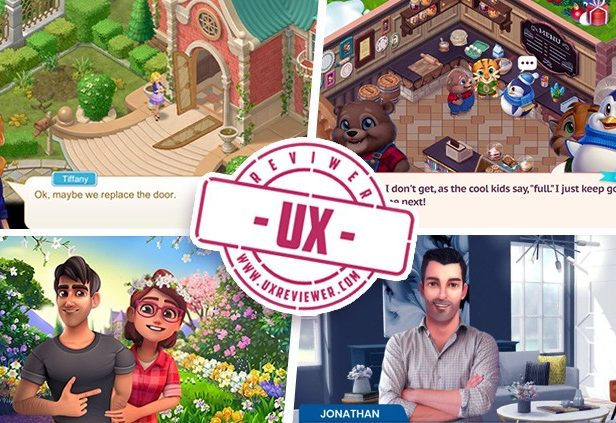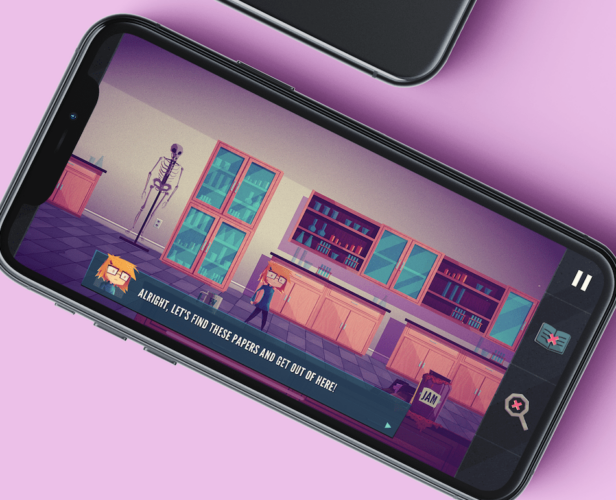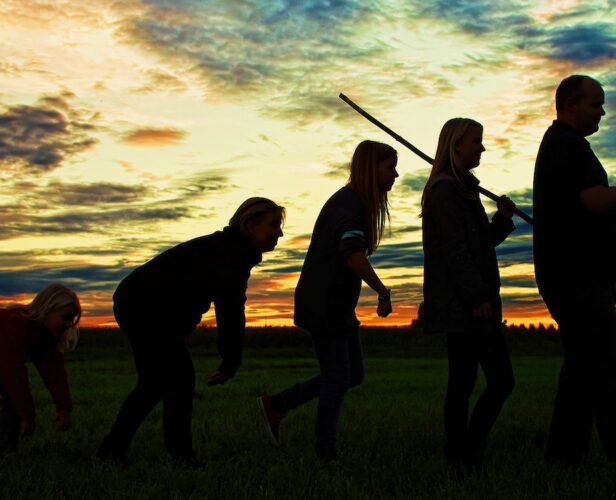Category
Game Design
#Game Design
5 Simple Ways to use Level Design to Improve Player Experience
Games have a great deal to learn from the likes of architecture, town planning, and even the layout of theme parks. That’s especially true when it comes to level design. A 3D adventure game, for example, is a space designed to be moved through; just as is the case with a city centre or a Disney resort. Head to Walt Disney World in Florida, and Space Mountain stands out from its surroundings, visible from multiple vantage points. That’s entirely deliberate. Its vertical height contrasts sharply with its environment, drawing the visitor’s eye. And yet most of the park’s paths to Space Mountain are indirect, taking looping, curving routes. The idea is that visitors are never told where to go. Instead, Space Mountain’s constant presence gently pulls people towards it. Those winding paths, meanwhile, give a sense of exploration and discovery....
#Game Design
The Voodoo Art Manual: How to Make Effective Game Art in Hyper-casual
Editor’s note: This article was originally published by Voodoo. You can read the original on their blog here. The brand new Voodoo Art Manual is now available for all partner studios on our Publishing Platform. It contains a concrete and practical guide on how to create effective and engaging game art in hyper-casual. We know that many of the studios we work with don’t always have dedicated game artists in their teams, and that it is often created by developers using the help of existing tools on Unity. Art, however, is an essential element of your game. It makes or breaks both the clarity of your gameplay and the user’s experience. Without effective art, the success of your game lies in the balance. The Voodoo Art Manual was created to maximize your chances of success in the prototyping phase. Whether you’re an experienced...
#Game Design
Voodoo Talks Trends: How to Stay Ahead of the Game in 2021
Editor’s note: This article was originally published by Théophile Tabary, Publishing Manager at Voodoo. You can read the original here. As Publishing Managers at Voodoo, we often receive questions on current and future trends in hyper-casual. Trends can be difficult to navigate for studios and developers; sometimes you want to be following trends, and sometimes you want to be creating new ones. We’re here to give you some guidance on how to approach trends when creating hyper-casual games, and how to stay ahead of the game in 2021. What are trends in the hyper-casual market? The first thing to remember is that there are several different types of trends in hyper-casual. Each type contributes to the market in a slightly different way, and it is helpful to define which category your ideas or prototype fit into in the ideation and...
#Game Deconstructions
How to Crack the Match 3 Code?- Part 2
Editor’s note: This article was originally published by Om Tandon, Innovation & UX Design Manager at Eaton. You can read the original version here. Match 3 metamorphosis is real but doesn’t new territory often comes with new rules? Let’s dive deeper into where the game is afoot in these uncharted waters. This multi-part analytical series is laser-focused on what some of these new rules might be. The last analysis in this series looked at some historical data coupled with powerful tectonic forces of maturing player behavior and deepening game design that has changed the lay of the land dividing the Match 3 landscape between Classic and Meta, ruled by the King’s and Playrix’s of the world. Yes, we are standing at a fork in the road folks but the real question is what does the road ahead looks like? This evolution is far from over for both Classic & Meta Match 3! What...
#Game Design
Storytelling in Blockbuster Casual Games: The Effect of Data and UX-Driven Trends
Editor’s note: This article is written in collaboration by Om Tandon of UXreviewer and Lisa Brunette, founder & owner of Brunette Games, a narrative design and storytelling powerhouse working with development teams at publishers and studios such as Jam City, Redemption Games, Uken Games, etc., on blockbuster top-100 grossing casual games: Sweet Escapes, Lily’s Garden, Matchington Mansion, & many others. You can find the original article on LinkedIn. But without further ado, let’s get started: How is modern-day storytelling in casual games evolving? What data & UX-driven trends are emerging in the narrative of blockbuster casual games? Let’s find out. Size of the Pie: Casual Puzzle Games Source: Deconstructor of Fun Casual games are the second-largest genre on mobile after strategy games. They generated a revenue of a whopping $8.1Bn in 2019, the lion’s share of which was raked in by the Match 3...
#Game Design
Adding Subtitles to Your Mobile Game – Dos and Don’ts
Subtitles might be one of the last things you think of. But they shouldn’t be – because they really do matter. Here are our thoughts on why, and some tips to help you get them right the first time. Subtitles are a must in today’s mobile games. And not just for gamers with hearing impairments. They’re important for lots of other ‘life’ reasons – people use them if they’re playing a game on public transport, because they have crappy speakers, if they’re trying not to disturb flatmates/children/significant others, and so on. While the numbers for mobile games aren’t really available yet, it’s clear that people playing on consoles are using subtitles – when Ubisoft tracked subtitle use on Assassin’s Creed: Origins, they found that 60% of players play with these switched on. And this is for a game that most...
#Game Design
Making a puzzle game? Avoid these 5 common mistakes
The puzzle game genre is arguably one of the most popular genres on the market, and has been around since the first smartphone was created (remember Cut the Rope?). There are hundreds, if not thousands of puzzle-like games on the app stores, all of which offer their own unique take on the genre. We’ve previously released articles on mistakes to avoid when you are creating a F2P game, but this time I want to focus my attention to puzzle. What makes a good puzzle? How can you make your game stand out? And most importantly, what mistakes should you avoid when working on yours? Here’s what I found… 1. Avoid breaking natural progression Progression tactics are a great way to get your player up to speed without overwhelming them. (Afterall, you wouldn’t start a newbie on a grandmaster level of...
#Game Design
4 Key Steps to Making a Successful Hyper-Casual game
Hyper-casual games became the hottest trend in the industry when developer Voodoo saw an exponential increase in downloads, which made them the third best performing game developer worldwide in 2017. Only Google and Facebook performed better, and the message was made clear: hyper-casual games are in-demand and can be extremely successful. Since having sustained this popularity, hyper-casual games now generate between $2 billion and $2.5 billion in annual revenue. People across the globe are now spending more time than ever playing games, and perhaps more significantly, they’re also engaging with advertising more – a trend that has played to the strengths of hyper-casual’s unique monetization model. The first quarter of 2020 saw hypergrowth in the hyper-casual vertical, with global installs doubling from December 2019 to March 2020. Users weren’t only downloading more hyper-casual games, they were also playing them more...
#Game Design
How to Crack the Match 3 Code? – Part 1
Editor’s Note: This article was originally published by Om Tandon, Founder/Games Consultant at UX Reviewer.com. You can find the original version of this post here. Since the early days of app store gaming, Match 3 games have been consistently one of the most popular top-grossing casual games category (Candy Crush Saga launched in 2012 being a classic example genre’s long reign). Reasons for this genre’s mass popularity with players have traditionally included: Simplified core loop with low barrier to entry for new players and first-time gamers Game mechanics leveraging mobile-first, intuitive touch gestures on smart devices like tap, swipe which even children can figure out (literally) Relatively less player effort & user friction via low strategy puzzle core loop. Short gameplay sessions with low time commitment making these games effortlessly easy to pick and drop on the go. You can successfully play a session in a...
#Game Design
So you want to make an RPG game? Here’s what you should know
The RPG genre has changed dramatically over the past few years. Going from pen and paper to tabletops, from desktop to mobile, the genre barely looks the same as it did all those years ago. Despite this, there are a few elements that hold true in them all. And in this post, my goal is to highlight what those elements are, how they work, and what you need to remember when making a hit RPG game. There are four main sections you can check out, so feel free to skip to something in specific: Audience Get your pacing right Smaller experiences Customization Let’s get started. So, who the hell plays RPG games? As you’ll probably know, audiences don’t just slip into one neat demographic. There are a ton of reasons why someone would play your game. If you look at...
#Game Design
How Voodoo Diversified and Lowered Game Product KPIs
Editors Notes: This article was originally published on LinkedIn by Youssef Gasmi, Communications Manager at Voodoo. Measurability of value has become a key factor in game publishing, a set of metrics that define what games get made, and which concepts are invested in. Successfully understanding the core strengths and the impact a game will have before it is released is a vital part of the development process in mobile games. This is becoming more important due to the highly competitive nature of the market in 2020. As result, what were once seen as hard and fast rules, namely 55% D1, 22% D7 retention and CPIs below $0.25 are now considered short-sighted. At Voodoo, we have become the leading publisher behind Hyper-Casual games, and we have used a robust testing methodology to establish a game’s retention, and cost per install values,...
#Game Design
5 Things to Consider When Designing Hyper-Casual Games
Editors note: This blog was written by hyper-casual specialists, JoyPac, and is based on their recent webinar: Design Strategies for Hyper-Casual Game Development. JoyPac specializes in publishing hit hyper-casual games across the globe, and today they have agreed to share their top tips and strategies. To develop a successful hyper-casual game at hyper-fast speed, you need to have a clear production process that focuses on game design. A lot of developers jump into creating hyper-casual games without proper planning and without proper testing. This often leaves them with little idea of how much appeal their game will have, and with a lot of hard work going to waste. We (JoyPac) recently hosted a webinar on this exact subject, along with Umami Games and SuperPlus Games. Based on that webinar, we’ve put together five major things to consider before you set...
#Game Design
A Beginner’s Dilemma: To Start With Casual Games or Mid-Core Games?
Editor’s Note: This post was originally published on LevelUp by Joakim Achrén, the Founder and CEO of Elite Game Developers, a Helsinki-based company that helps gaming entrepreneurs in starting their first games company. One of the earliest and most important decisions founders face when starting a games company is the level of complexity of their first game: should it be casual or mid-core? As an angel investor, every week I get to take a look at pitches from founders and I see them struggling with the same problems over and over again. So, how does one decide where to start and which approach will bring the most successful long-term? Here’s what I’ve learned through my experiences creating a games company and going through countless pitches since. The economics of mobile game ventures After hearing the pitch for a game, I...












